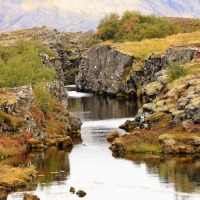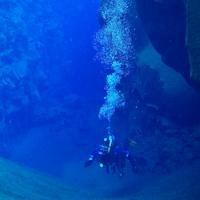There are three major national parks in Iceland that protect different parts of the country. The oldest of these national parks is þingvellir National Park.
Thingvellir National Park was established in 1928 to protect the remains of the assembly site and covers an area of approximately 23,700 hectares. The park in the southwest of the country is one of the most visited places on the whole island and was even declared a UNESCO World Heritage Site in 2004 due to its historical significance. This is because þingvellir is not only one of the few places in the world on land where you can see two continental plates moving away from each other, but it is also one of the most important places in the history of Iceland. The name " þingvellir" means gathering fields and is due to the original use of the place.
For several years now, there has been a visitor center at Hakid next to the viewing platform, where guests can get information about the park and the sights, and purchase small souvenirs. The visitor center also offers (for a small entrance fee) the opportunity to learn more about the history and nature of the national park with the interactive exhibition "Heart of Iceland" during a 40-60 minute tour. In addition to the visitor center, there is also a service center where visitors can get general information about the park, maps of the hiking trails, and information about sights in the area and the condition of the roads. There is also a small cafeteria where you can get snacks and drinks.
If you want to explore the national park on your own, you can easily do so on numerous hiking trails or on the back of an Icelandic horse. Lake Thingvallavatn also offers many places where fishing is allowed with a license.
Tip: During the summer, the national park rangers organize two free tours of the park every day. The first starts at 10 AM at Thingvallakirkja (the church) and the second at 2 PM at the visitor center. The tours are in English and last approximately one hour each.




Location & Approach
The park is located about 45 minutes from Reykjavik in the southwest of the country and is a stop on the Golden Circle. By car, the visitor center is best reached via Ring Road (Road 1) and Road 36. The park is located at the upper end of Lake Thingvellir.
There are several paid parking lots in Thingvellir Park:
- P1 Hakid: At the visitor center next to the viewpoint at the upper end of Almannagjá Gorge.
- P2 Fossplan: Two parking lots near Öxaráfoss and the meeting field.
- P3 Valhöll: On the southern side of the meeting field
Historical significance
In 930 AD, the first general assembly, the Althing, was held in the National Park after an envoy from the clans in Iceland traveled to Norway to learn the laws and customs there and adopt them as a model for the new society. The Althing is thus one of the oldest parliamentary assemblies in the world.
After its founding, the Althing met annually on a rock formation called "Law Rock" to set aside disputes, pass laws, and try criminals. These sessions continued until 1798 when Iceland became part of the Norwegian monarchy.
Over the centuries, some important political decisions took place in Thingvellir National Park:
- In 1000, the decision was made there to convert to Christianity and abandon belief in the Norse gods and paganism
- Between 1271 and 1273 the law of the Norwegian king Magnus VI was adopted there in several sessions
- In 1944 the sovereignty of Iceland was restored there after a union treaty with Denmark had already been signed in 1918
Geological significance
During the last ice age, the whole country was covered by a layer of ice more than 3,300 foot thick. Under this ice layer, however, there was strong volcanic activity in many places, which caused volcanic eruptions to melt the glacial ice in some places and form cavities under the ice or breakthroughs. In the cavities, lava formed palagonite mountains and long palagonite ridges.
As the temperature rose 18,000 years ago, the glacier began to melt, revealing the first evidence of Lake Thingvallavatn about 12,000 years ago. As the glacier retreated northward, the meltwater collected in a depression, forming the lake and revealing the palagonite mountains previously hidden by the ice.
About 10,000 years ago, the glacier reached its present position and a shield volcano eruption began, forming Mount Skjaldbreiður and a shield volcano south of Mount Hrafnabjörg. As the water level in the lake rose, it sank at the same time, as the lava filled most of the lake and flattened the lake in this way.
About 3000 years ago, þjófahraun was formed by opening an 5 mile long eruptive fissure northeast of Hrafnabjörg.
The last eruption in the Thingvellir depression took place 1000 years ago and the resulting eruptive fissure is located northeast of Mount Hengill. The lava flowed into the lake Thingvallatn and the ash crater Sandey was formed. Since this eruption, volcanic activity at Thingvellir has been dormant, but it is not a question of if, but rather when it will resume.
Sights around the National Park
 Silfra Rift:
Silfra Rift:
Silfra is a submerged canyon within Thingvellir National Park, formed by the drifting apart of the North American and Eurasian continental plates. The crevice is one of the best places in the world for divers and snorkelers. The clear glacier water has temperatures around freezing point and impresses with a visibility of up to 330 feet.
Davíðsgja Rift:
In addition to the Silfra Rift, there is another place in Lake Thingvallavatn that is ideal for diving: the Davidsgja Rift. The crevice is located in the northeast of the lake and can only be reached by swimming. It is not as well known as the Silfra Rift, but it is especially popular with local divers. The water is usually warmer than in the Silfra Rift, but visibility is more dependent on the weather.
Alamannagjá - The Allmen Gorge:
The gorge is an impressive geological formation formed by the drifting apart of the North American and Eurasian tectonic plates. There is an observation platform at the edge of the gorge, with stairs leading to the hiking trail through the gorge.

Lögberg:
Logberg is also known as the "Law Rock" because it is where the laws of the Commonwealth were promulgated by the Law Speaker from 930 - 1262. In addition to the proclamation of the laws, any person could come forward here and express their opinion, report on events and make speeches. The exact location of Logberg cannot be confirmed yet but two rocks are considered probable based on documents and paintings. The probable rock is marked with a flag so that visitors can find it.
Lake Thingvallavatn:
Lake Thingvallavatn is the largest lake in Iceland and is partially located in the National Park. It offers impressive scenery and the possibility of boating across the lake and fishing (with permission).
Öxaráfoss Waterfall:
Oxarafoss is located in the Allmannagjá - the Allmans Gorge and rises from the river Öxará. It is believed that the waterfall was artificially diverted to direct the water near the meeting place. At the foot of the waterfall, it is wonderful to have a picnic and admire the picturesque surroundings.

Þingvallakirkja:
The current Thingvallakirkja was built in 1859, but legend has it that there has been a church in the same spot since 1017. The church is normally closed except when a staff member is on site. This is usually at 10 AM when the free guided tour by the park rangers begins at the church.
Camping
In the National Park, the two campsites at Leirar and Vatnskot invite you to stay. In summer the two campsites are open from June to September and in winter you can camp at the Leirar site near the service center. The toilets and washrooms are open all year round but the showers are closed from December 1 to April 1. There are more toilets at the Silfa rift. In summer, the campsites are monitored by park rangers, sometimes overnight, to ensure peace and order.
Nearby
Due to its location on the Golden Circle, there are also a number of other spectacular sights near Thingvellir National Park. These include the Gullfoss waterfall, the Geysir and geothermal area, the city Selfoss, and the historic village of Skálholt.
